Are you struggling with inefficient customer service, high operational costs, or the need for 24/7 support?
Don’t worry–there’s a solution for your troubles.
Chatbot development is a process of creating automated conversational agents that interact with users via text or voice.
By implementing chatbots, you can offer immediate responses, personalize experiences, and streamline operations.
But—
How do you go about this process? And what are the best strategies you can leverage for successful implementation?
Stay tuned as we’ll explore all these topics, and then some.
Leverage the power of AI chatbots today
Let’s start from the top—
AI chatbot development in 6 steps
Crafting an effective chatbot is more than just writing code. It’s about understanding user needs, designing intuitive conversations, and continuously refining based on user interactions.
By following these best practices for chatbot development, you’ll be well-equipped to create a bot that not only operates seamlessly but also offers an engaging customer experience.
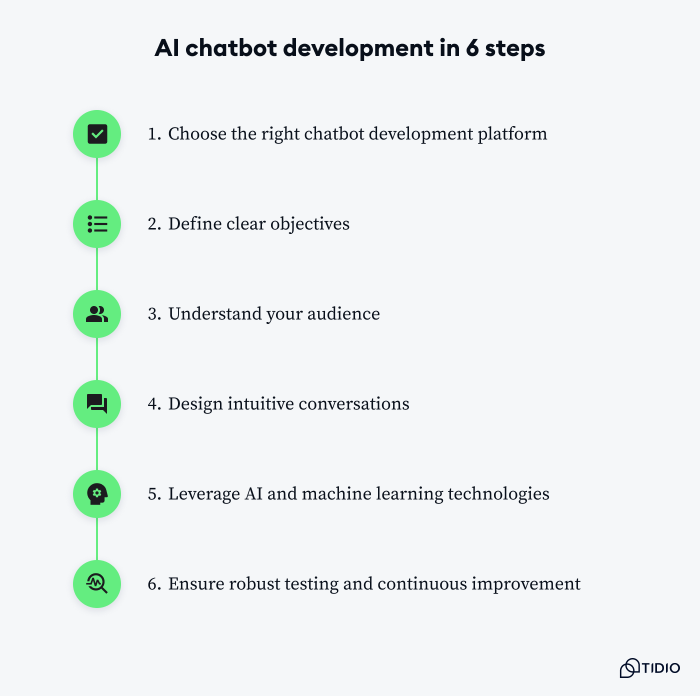
Step 1: Choose the right chatbot development platform
Selecting the appropriate chatbot platform is crucial for every successful chatbot development. First, check whether you need a chatbot that handles simple queries or if you need one for complex, dynamic interactions. Some platforms offer technologies like artificial intelligence (AI) and natural language processing (NLP) algorithms whereas other systems work based solely on predefined scenarios.
Next, ensure that the platform you choose integrates easily with your existing systems such as customer relationship management (CRM), ecommerce platforms, and other digital tools. Also, consider the level of programming skills required to use the platform effectively. On top of that, evaluate the customization and scalability options of the platform to ensure it can grow and evolve with your needs.
Last but not least, look for platforms that offer robust chatbot analytics and embedded reporting tools. Understanding how users interact with your chatbot can provide valuable insights and help you make data-driven decisions to improve its performance over time.
Read more: Find out how to easily build an NLP chatbot. Also, check out the difference between virtual assistants and chatbots.
Step 2: Define clear objectives
Before diving into development, it’s essential to define what you want your chatbot to achieve in the first place. Are you aiming to improve customer service, assist with product recommendations, or automate repetitive tasks?
For example, if your goal is customer service, you should focus on automating responses to common inquiries like order tracking or FAQs. This clarity will guide your design and chatbot development process, ensuring that your chatbot remains aligned with your business goals.
Additionally, having well-defined objectives allows you to measure the chatbot’s success more effectively once it’s deployed. By setting specific, measurable goals, such as reducing response times and increasing user satisfaction scores, you can track progress and make informed adjustments. Moreover, clear objectives help in setting client expectations and designing interactions that are intuitive and valuable, thereby enhancing the overall user experience.
Read more: Explore FAQ chatbots and their most frequent use cases for inspiration. Also, while you’re at it, learn all you should know about chatbots for lead generation.
Step 3: Understand your audience
Carefully analyze the chatbot target users and their expectations. Create user personas to identify their needs, preferences, and potential pain points.
This will help you determine the bot’s development and UI. For example, if your target audience includes tech-savvy users, design a chatbot capable of advanced interactions. On the other hand, for a broader audience, you should keep interactions simple and intuitive.
Understanding your audience also involves recognizing the language and tone that resonate best with them. Tailoring your chatbot’s language style, whether formal, casual, or even humorous, can create a more engaging user experience. Additionally, consider any cultural or regional nuances that might affect interactions, and ensure multilingual capabilities and support aside from English for your international audience.
By aligning the chatbot’s personality and communication style with your audience’s expectations, you enhance user satisfaction and increase the likelihood of successful interactions.
Read more: Find out all you need to know about the topic of multilingual chatbots.
Step 4: Design intuitive conversations
Focus on designing a natural and intuitive conversation flow so that your bot can easily mimic the style of human conversations. To do this, map out potential customer journeys and consider various scenarios where users might deviate from the expected path.
In addition, if a user asks a question the chatbot can’t answer, make sure there is a fallback option of escalating to a human agent or providing a helpful resource. This will create a smoother user experience and prevent frustration, ensuring a more positive interaction.
To further enhance the conversational design, incorporate prompts, quick replies, and buttons to guide users through interactions. These tools can help keep the conversation on track and make it easier for users to navigate through different options without confusion.
Additionally, ensure that the chatbot is capable of understanding context and maintaining the flow of conversation, even when users switch topics or make unexpected queries. This level of sophistication in conversation design will make interactions feel more natural and engaging.
Read more: Check out the essential chatbot flowchart and tree diagram templates. Also, learn how to write chatbot scripts with examples and dialog templates.
Step 5: Leverage AI and machine learning technologies
Incorporate AI and machine learning to enhance your chatbot’s capabilities over time. Train your chatbot using diverse datasets that reflect the variety of interactions it may encounter.
For example, use natural language processing (NLP) techniques to handle different ways of phrasing the same question. Then, continually monitor the bot’s performance and gather user feedback to make necessary adjustments and improvements. By using this data-driven approach, your AI chatbot will become increasingly accurate and responsive over time.
In addition to improving accuracy and responsiveness, leveraging AI and machine learning allows your chatbot to offer personalized experiences based on user behavior and preferences. By analyzing past interactions, the chatbot can tailor responses and recommendations to individual users, making the communication more relevant and engaging. This not only enhances user satisfaction but also builds a more human-like interaction.
Step 6: Ensure robust testing and continuous improvement
Before launching, rigorously test your chatbot in various scenarios to identify potential issues or gaps in its performance. Use beta testing with real users to receive valuable customer feedback and make refinements.
Then, post-launch, continue to monitor interactions, analyze performance metrics, and update the chatbot regularly. Implementing a cycle of continuous improvement ensures that your chatbot remains effective, relevant, and capable of meeting your evolving business needs.
So—
By following these steps and best practices, you can develop a type of chatbot that not only operates smoothly but also enhances user satisfaction through intelligent, context-aware interactions.
Now, it’s time to check out the best platforms you can use for chatbot development.
Best chatbot development platforms
Choosing the right platform is a critical first step in your chatbot development journey. With numerous options available, picking the ideal platform can seem daunting. After all, so many tools offer unique features, ranging from advanced NLP capabilities to robust user interfaces for quick chatbot deployment.
But don’t worry. We did the research for you. So, here’s a table of the top chatbot development companies for a quick comparison:
| Chatbot app development company | Rating | Free plan/trial | Best for |
|---|---|---|---|
| Tidio | 4.7/5 ⭐️ | ✅ | AI chatbots |
| BotsCrew | 4.7/5 ⭐️ | ❌ | Enterprise chatbots |
| Botsify | 4.2/5 ⭐️ | Free trial | Automation capabilities |
| Chat Stay | N/A | ❌ | Third-party integrations |
| Chit Chat | N/A | ❌ | Omnichannel services |
1. Tidio
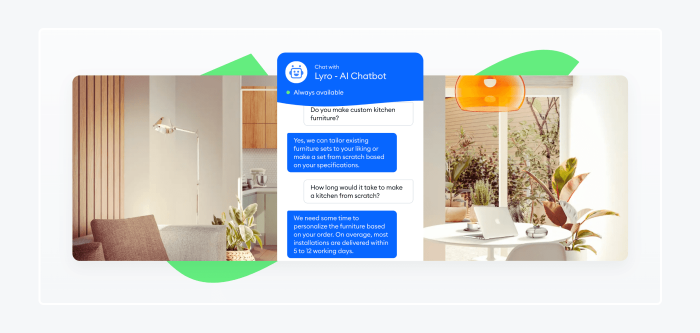
Reviews: 4.7/5 ⭐️ (1,535+ reviews)
While Tidio is not a chatbot development service per se, the platform does allow you to create a chatbot and use it with no coding required. The tool also offers premade chatbot templates for sales, lead generation, and other ecommerce purposes. Lyro, Tidio’s AI chatbot works on the principle of generating data from the existing FAQ base and then using it to answer customer queries in a natural, human-like manner.
Main features:
- NLP and FAQ chatbots
- Intuitive drag-and-drop chatbot builder
- Multichannel functionality for web and social media
- Robust live chat widget
- Ecommerce integrations with platforms like WooCommerce, Shopify, and Magento
Pricing:
- 7-day free trial available
- Free version available
- Starter ($24.17/mo)
- Growth (starts at $49.17/mo)
- Plus (starts at $749/mo)
- Premium (starts at $2999/mo)
Read more: Be sure to check out how Lyro successfully automated Tidio’s customer support efforts.
Start using Tidio AI chatbot and skyrocket your online business
2. BotsCrew
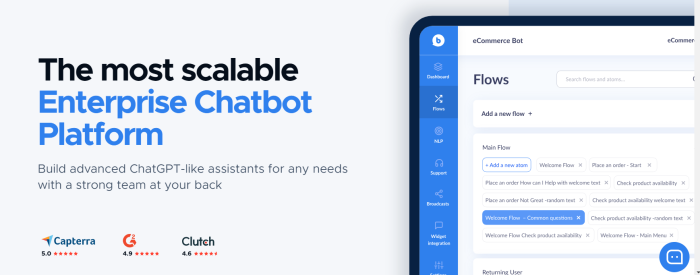
Ratings: 4.7/5 ⭐️ (10+ reviews)
BotsCrew is an easy-to-use chatbot platform that allows brands to develop chatbots to attract and retain clients. It lets you automate and scale consumer interactions on leading messaging channels, including Facebook, WhatsApp, Instagram, and others. The bot-building features are intuitive to use, and there’s also a multilanguage function that makes it easy for you to interact with customers worldwide.
Main features:
- Intuitive interface
- Integrations with your tech stack
- Developer’s support
- Contact sales
3. Botsify
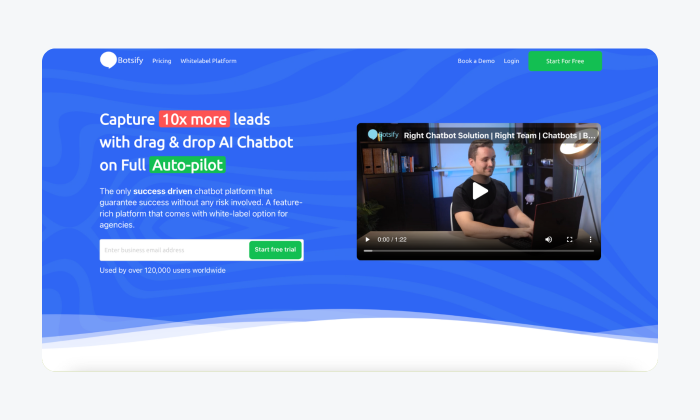
Ratings: 4.2/5 ⭐️ (10+ reviews)
Botsify is an all-in-one chatbot development tool that allows businesses to create AI-based, intelligent chatbots with ease. This platform stands out thanks to its multichannel client support. This includes integrations with your website as well as social media messaging platforms such as WhatsApp, Facebook Messenger, and Instagram.
Main features:
- Chatbot automation to accelerate lead generation, support, and sales process
- Integrations with platforms like WordPress, WooCommerce, and Shopify
- Solutions for multiple industries, including real estate, retail, and ecommerce
- Free 14-day trial available
- Do it yourself ($49/mo)
- Done for you ($149/mo)
- Custom → contact sales
Read more: Explore the topic of real estate chatbots and find the one most suitable system for your needs. Also, check out the best WordPress chatbots and Shopify chatbots available on the market.
4. Chat Stay
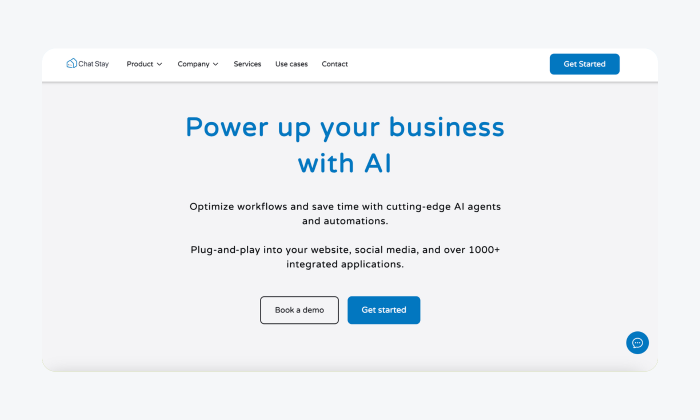
Ratings: N/A
Chat Stay is a chatbot development agency that offers services like chatbot software development and AI consulting, among others. The business focuses on enhancing conversational design, workflow, knowledge response, and model tuning. Moreover, Chat Stay can help you easily connect an AI assistant with over 1,000 websites and mobile apps. The industries they cover include hospitality, education, ecommerce, health care, and real estate.
Main features:
- AI and enterprise consulting
- Maintenance support and migration
- 24/7 multilingual AI agents
- Book a call with sales team for pricing and demo
5. Chit Chat
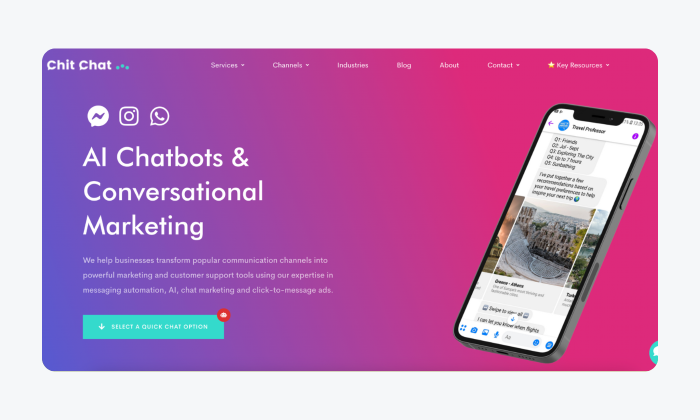
Ratings: N/A
Chit Chat is a messaging automation tool that offers AI and chatbot app development services. They design and build chatbots based on customers’ individual needs. This platform also lets you use their integration services to leverage the power of GPT and AI in your chatbot development.
Main features:
- Omnichannel customer service functionality
- Custom-built chatbots based on client needs
- Quick replies, natural language processing, and dynamic content
Pricing: Contact sales team for pricing and demo
Read more: Explore the topic of WhatsApp chatbots and find out the top Instagram chatbots on the market.
Industries that should use AI chatbot development
Exploring the potential of AI chatbot development opens up numerous opportunities across various industries. From client service to healthcare, chatbots are revolutionizing how businesses interact with their audiences.
In this section, we’ll delve into the industries that can benefit significantly from implementing AI chatbots. By understanding the advantages these automated agents bring to each sector, you’ll see why adopting chatbot technology is becoming vital for staying competitive in your field.
Let’s explore the industries that will benefit most from this software:
1. Retail
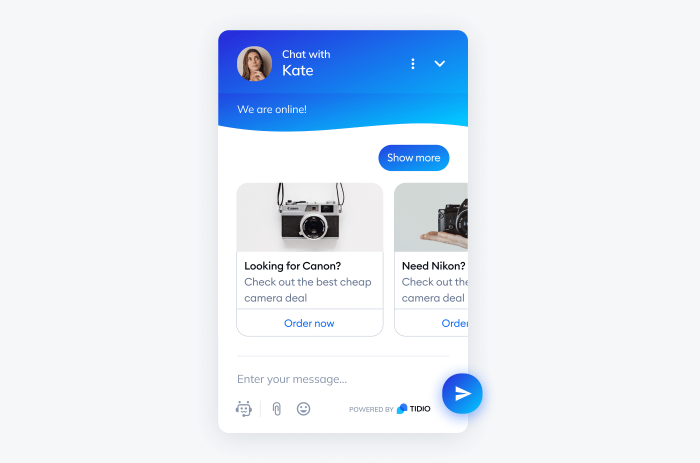
The retail industry can significantly benefit from chatbot development by enhancing client service and streamlining the client journey. Chatbots can provide personalized product recommendations based on a customer’s browsing history and preferences, ensuring a tailored shopping experience as a whole.
For instance, a retail chatbot can guide shoppers to the right products by asking about their needs and preferences, reducing bounce rates and increasing conversion rates. Customized experiences are especially important as 52% of users expect offers to always be personalized.
Moreover, a shopping bot can handle post-purchase support such as order tracking and handling returns or exchanges. This will free up your human service representatives to handle more complex inquiries and significantly reduce waiting times.
Read more: Check out the ultimate customer service chatbot guide. In addition, learn what virtual shopping assistants are and how to use them effectively.
2. Finance
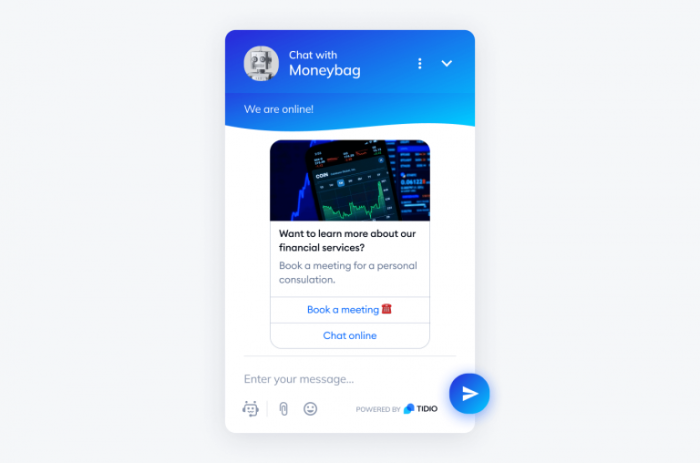
In the finance industry, chatbots can play a crucial role in providing efficient client support and automating routine tasks. They can handle inquiries about account balances, recent transactions, and assist with more complex tasks such as applying for loans or managing investments.
Additionally, banking chatbots can help with fraud detection and prevention by monitoring transactions in real time and alerting users of suspicious activities. This contributes to greater security and trust between financial institutions and their customers. The deployment of chatbots in finance not only enhances operational efficiency but also improves the overall user experience.
Read more: Find out all about chatbots for business and sales chatbots.
3. Healthcare
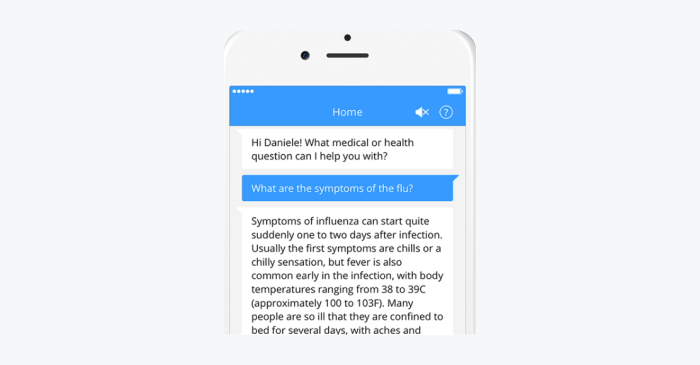
Healthcare is another industry that stands to gain immensely from chatbot development. Chatbots can assist with appointment scheduling, reminders, and even provide preliminary medical advice based on symptoms described by patients.
Furthermore, chatbots can help to manage patient records and follow-ups, ensuring that care providers have up-to-date information on patient history as well as treatment plans. This leads to more coordinated and efficient workflows. By automating administrative tasks and providing immediate information, healthcare chatbots free up medical staff to focus on direct patient care, enhancing both efficiency and patient satisfaction.
4. Hospitality
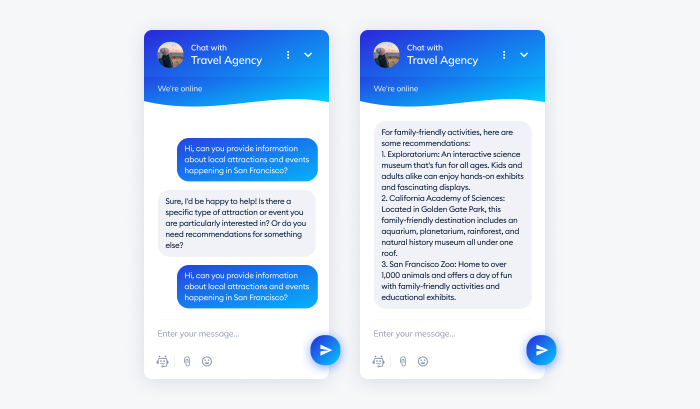
In the hospitality industry, chatbots can transform the guest experience by providing instant assistance and personalized recommendations. From booking rooms to answering inquiries about amenities and local attractions, chatbots can handle a wide range of tasks that improve the customer experience.
Moreover, chatbots can gather feedback and address complaints in real time, allowing hotel and restaurant staff to resolve issues promptly and enhance guest satisfaction. By automating these interactions, hotels can provide a higher level of service without increasing operational costs.
Read more: Learn all about the topic of restaurant chatbots.
5. Ecommerce
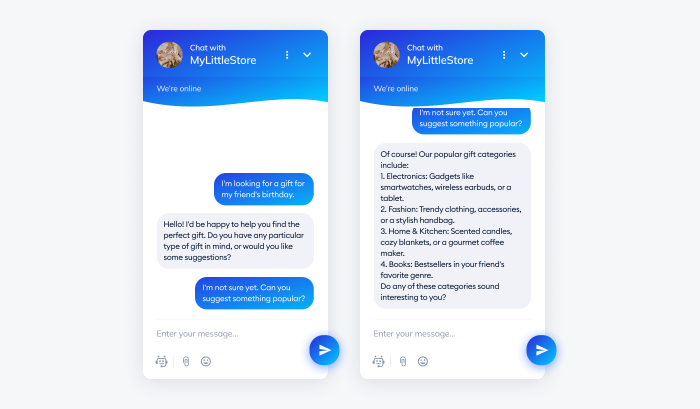
Did you know that providing 24/7 client support via chatbots can significantly enhance user experience and satisfaction? In fact, a whopping 83% of consumers want to receive immediate assistance after contacting a business, which is all the more reason to use chatbot automations in your everyday ecommerce store operations. Moreover, 89% of consumers state they will buy from a business again after just one positive user experience.
Aside from assisting shoppers around the clock, an online store chatbot can help clients find specific items and suggest similar products. They can even guide them through the checkout process, significantly reducing shopping cart abandonment rates.
Additionally, ecommerce chatbots can handle customer service tasks such as processing returns, tracking orders, and resolving common issues without the need for human intervention. This not only improves customer satisfaction but also allows human agents to focus on more complex problems.
Read more: Here are the most practical chatbot use cases you should know about. Also, be sure to check out the top returns management software for your business.
All in all, by adopting chatbot technology, these industries can enhance efficiency and maintain a competitive edge in an increasingly digital world.
Chatbot application development: key takeaway
Chatbot development is revolutionizing the way businesses connect with their clients. By offering quick, personalized, and efficient service, chatbots help to enhance user satisfaction and streamline various operations. Whether it’s retail, finance, or ecommerce, chatbots manage routine inquiries, provide instant support, and offer tailored recommendations, allowing human agents to concentrate on more complex tasks.
Once again, here’s a recap of best practices for chatbot development:
- Choose the right platform
- Define clear objectives
- Understand your audience
- Design intuitive conversations
- Leverage AI and machine learning
- Conduct robust testing
Advancements in AI and machine learning are making chatbots smarter and more capable of understanding and responding to user needs dynamically. By adopting best practices and carefully selecting the right chatbot development platform, businesses can build chatbots that exceed customer expectations. So—start exploring the power of chatbot development today and transform your client interactions like never before.
Start using Tidio AI chatbot and skyrocket your online business
Frequently Asked Questions
Chatbot development involves creating automated conversational agents or voice assistants that interact with users through text or voice commands. These chatbots are designed to perform tasks such as answering questions, providing customer service, or assisting with various tasks based on user input.
To develop your own AI chatbot, first define the purpose and scope of the software. Next, choose a development platform like Tidio, BotsCrew, Botsify, Chat Stay, or Chit Chat. Design the conversation flow by mapping out potential user interactions. Then, develop the chatbot by using the platform’s tools to create user intents, entities, and responses. Finally, test the chatbot thoroughly and continuously refine it based on user feedback and performance metrics.
Yes, but creating your own version of OpenAI’s ChatGPT-like chatbot involves several key steps. First, familiarize yourself with natural language processing (NLP) and machine learning (ML) concepts. Choose a suitable framework or library such as TensorFlow or PyTorch (see what is PyTorch for more), and gather a large dataset of conversational text to train your model. Opt for a robust model architecture like GPT-3.5 or GPT-4, which can be fine-tuned to your specific needs. Training the model requires significant computational resources, so ensure you have access to powerful GPUs or TPUs. Finally, continually monitor performance and refine your model to enhance accuracy and responsiveness over time.

